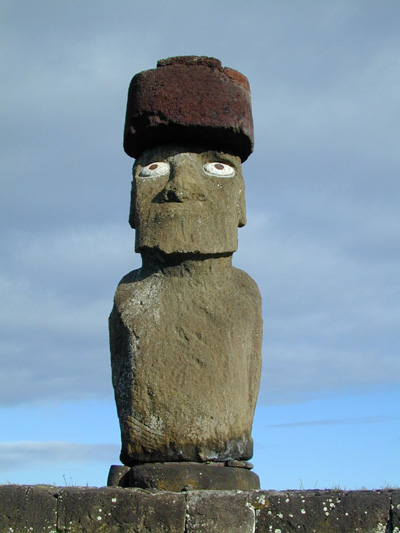
RAPA NUI: A CASE STUDY IN ECOLOGICAL DISASTER
By Nick Gier
Note: To execute pictures go to www.class.uidaho.edu/ngier/EasterIs.htm

The first surprise in arriving at Rapa Nui, after a 5 hour flight from Chile, is the landing strip--incredibly long for a 66-square-mile island with 4,000 people. In 1986 NASA received permission from the Chilean dictator Augusto Pinochet to improve the airport so that it could be used for emergency landing for the Space Shuttle.
Initially, the islanders were against the plan, especially after one archeological site was destroyed in the earth moving. Our Elder Hostel guide told us that the natives are now excited about the fact that a space ship might land there, and they are also pleased with the increased number of tourists, bringing much needed revenue to a subsidized economy.
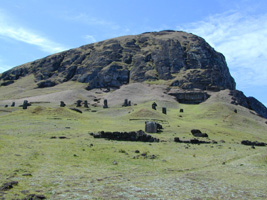 The
second surprise is the island does not have the lush topical landscape that
other
The
second surprise is the island does not have the lush topical landscape that
other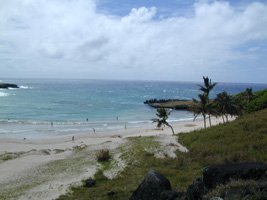 Pacific islands do. Except for the trees in the only town Hanga Roa, the palms
planted by Thor Heyerdahl at the only beach, and the trees at a Scottish sheep
ranch house, Rapa Nui is a vast expanse of grass and volcanic craters.
(Rano Raraku crater at left and Anakena Beach on right.)
Pacific islands do. Except for the trees in the only town Hanga Roa, the palms
planted by Thor Heyerdahl at the only beach, and the trees at a Scottish sheep
ranch house, Rapa Nui is a vast expanse of grass and volcanic craters.
(Rano Raraku crater at left and Anakena Beach on right.)
Dutch sailors named it Easter Island when they accidentally sailed upon it on April 5, 1722. The island was once covered by Chilean wine palms, some 65 feet high and 7 feet across, and some red ash trees stood 100 feet tall. Scientists have found the ancient pollen to prove the existence of this vast forest.
The best estimate of when Easter Island was first settled is around AD 900. By 1600 most of the trees were gone, and the once expert ocean sailors met the Dutch ship in small leaky reed boats. The sea-going craft that once brought in large quantities of dolphin and tuna could no longer be built.
The population of Rapa Nui could have peaked at 30,000 people, and they were divided into about a dozen tribes. They honored their ancestors by making huge stone statues (moai), and competition among the tribes about "who had the biggest" got out of control.
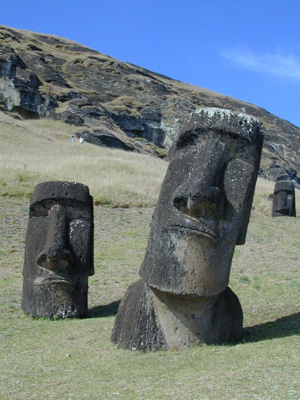 The
early statues weighed about 10 tons but the later ones were as
The
early statues weighed about 10 tons but the later ones were as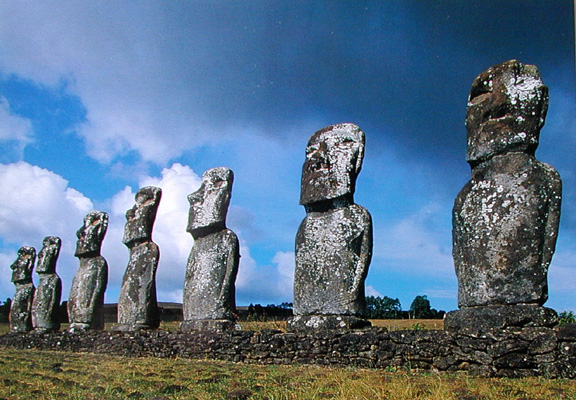 much as 75 tons (right), so massive that not even a
Japanese super crane, brought to the island in 2006, could lift them. The
largest one, lying unfinished in the quarry at Rano Raraku (left),
is estimated at 270 tons.
much as 75 tons (right), so massive that not even a
Japanese super crane, brought to the island in 2006, could lift them. The
largest one, lying unfinished in the quarry at Rano Raraku (left),
is estimated at 270 tons.
The land was cleared to plant yams, taro, bananas, and sugar cane, and a vast amount of wood was used to cremate the dead, the only Polynesians to have done so. Trees were also felled for cooking fires and to build frames or rollers to move the moai. Scientists believe the deforestation on Rapa Nui was one of the most extreme in human history.
Every wine palm nut recovered had the distinctive marks of rat teeth, which destroyed the nuts as fertile seed. The rats had been brought by the original settlers for food, but they helped the humans kill off the six species of land birds as well as the wine palms.
The once shaded upland plantations were now exposed to the wind and sun, and they suffered severe erosion and loss of fertility. These productive fields were abandoned between 1400 and 1600. With very little food from the sea, the result was widespread malnutrition, starvation, and cannibalism, although the latter has been disputed.
When Captain James Cook arrived in 1772, he described the people of Rapa Nui as "small, lean, timid, and miserable," although later visitors reported that the natives were still healthy and robust. Cook had brought a Polynesian guide with him, so for the first time Europeans could communicate with the natives.
The natives called their island "The Navel of the World," but they eventually accepted the name Rapa Nui. It came from Cook's guide, who came from a small island named Rapa Iti, which literally means "small island." When he first saw the island, he exclaimed "Rapa Nui," big island!
Competition for scarce resources led to war among the tribes and a loss of faith in the mana of the moai. Eventually every statue on the island was tipped over and deliberately broken by a large stone placed in its path. The eyes made of white and black coral, having empowered the moai, were also destroyed.
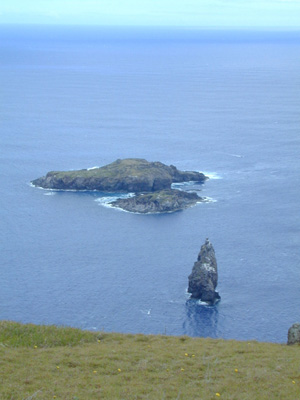 The
Rapanuians were again united by a Bird Man Cult (the man
who returned with the first tern egg from the island on the left
validated his tribal head as the island's chief for the year),
and their numbers had been reduced to about 6,000. In 1862 Peruvian slave ships
carried off most of the able bodied men to work in guano mines. A Catholic
priest objected to this crime and those who returned brought small pox back to
the island. There were only 111 inhabitants left in 1872.
The
Rapanuians were again united by a Bird Man Cult (the man
who returned with the first tern egg from the island on the left
validated his tribal head as the island's chief for the year),
and their numbers had been reduced to about 6,000. In 1862 Peruvian slave ships
carried off most of the able bodied men to work in guano mines. A Catholic
priest objected to this crime and those who returned brought small pox back to
the island. There were only 111 inhabitants left in 1872.
Devastation, both human and physical, has marked the history of what was once a lush subtropical paradise. As we celebrate Earth Day this week, we need to be reminded of the absolute necessity of forests and watersheds, and we also need to remember that not all ancient peoples lived in harmony with their land.
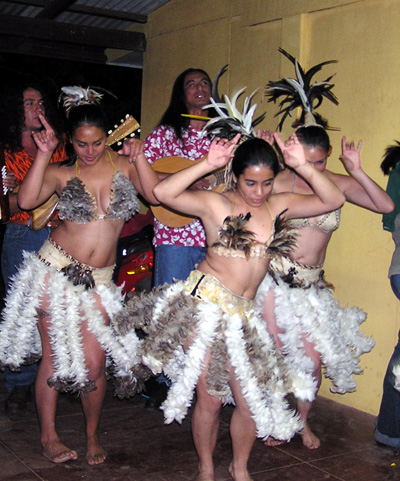 Postscript:
Because the people identify much more with Polynesia rather than Chile, there is
an independence movement on the island. Rapa Nui's dancers (left),
although more genetically mixed, travel often to cultural events on other
Pacific island and frequently win dancing contests.
Postscript:
Because the people identify much more with Polynesia rather than Chile, there is
an independence movement on the island. Rapa Nui's dancers (left),
although more genetically mixed, travel often to cultural events on other
Pacific island and frequently win dancing contests.